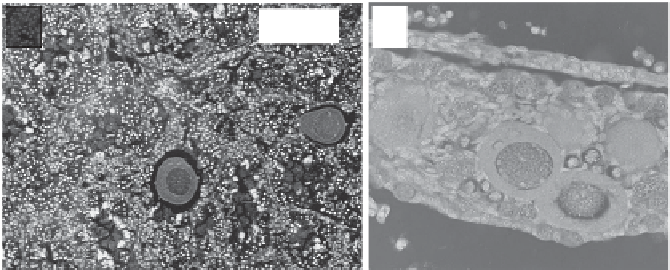Biology Reference
In-Depth Information
50 µm
100 µm
(b)
(a)
FIGURE 9.12
Testis tissue from (a) an adult male green frog (
Rana clamitans
) collected from an agricultural landscape display-
ing testicular oocytes (arrows) (photo donated by Susan Bolden; for more information, see Skelly et al. 2010), and
(b) a juvenile leopard frog (
Rana sphenocephala
) displaying ovotestes (>30% area with testicular oocytes) follow-
ing laboratory exposure to 1 μg L
-1
of atrazine (photo donated by Sara Storrs-Méndez; for more information, see
Storrs-Méndez and Semlitsch 2010).
gonadal dysgenesis (36% and 12% at 0.1 and 25 ppb, respectively). The more pronounced
response at the lower concentration was emphasized by the authors, who advocated an
“inverted U” response as one that could be expected within the realm of endocrine dis-
ruption (Hayes 2005). Several subsequent studies have consistently failed to demonstrate
similar gonadal abnormalities with incidences significantly greater than control animals
among several species, including
X. laevis
(Coady et al. 2005; Oka et al. 2008; Kloas et al.
2009a)
R. pipiens
(Orton et al. 2006; Langlois et al. 2010a),
Hyla versicolor
(LaFiandra et al.
2008), or
Limnodynastes tasmaniensis
(Spolyarich et al. 2010), although exposure to estradiol
as a positive control will produce TOs (see below).
Concurrent with their laboratory studies with
R. pipiens
, Hayes et al. (2003) described
incidences of these same gonadal morphologies among leopard frogs collected from across
the midwest of the United States in regions of low or high atrazine use. Male frogs exam-
ined at these sites were shown to exhibit morphologies that were similar to those induced
by atrazine in the laboratory. Gonadal dysgenesis was observed in 28% of male frogs at
one site where atrazine was widely used, a corn field in Nebraska where the atrazine was
reported at a concentration of 0.8 ppb. Moreover, varying incidences of TOs were observed
among male leopard frogs at sites where atrazine was detected. The site with the highest
incidence of TOs (92%), a “wildlife area” in Wyoming, had relatively low concentrations
of atrazine (0.2 ppb; the detection limit for the study), and although Hayes (2005) has sug-
gested that low atrazine concentrations present a greater risk because of an “inverted U”
response, a U.S. Environmental Protection Agency (EPA) data evaluation report (Steeger
et al. 2003) observed that a clear dose relationship was not evident in the data of Hayes et
al. (2003).
One of the difficulties in interpreting the occurrence of ambiguous morphologies such
as TOs and ovotestis (OVT; >30% infiltration of testis with TOs) is the general plasticity of
amphibians with regard to sexual phenotype, because:
1. Environmental conditions during development can alter sexual phenotype;
2. Ambisexuality and developmental hermaphroditism are natural phenomena
among many amphibians.








Search WWH ::

Custom Search